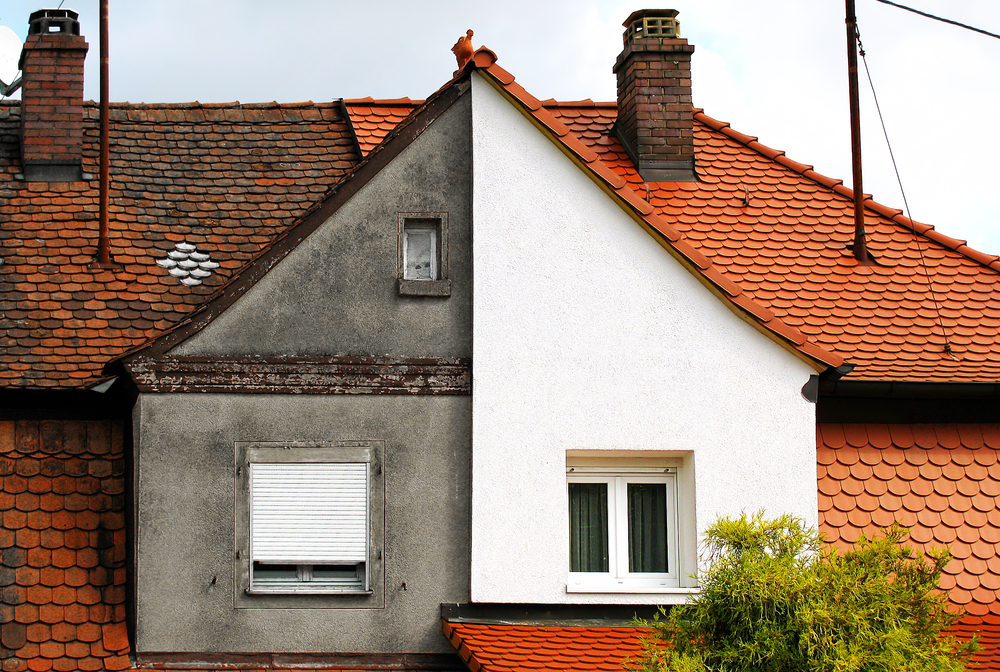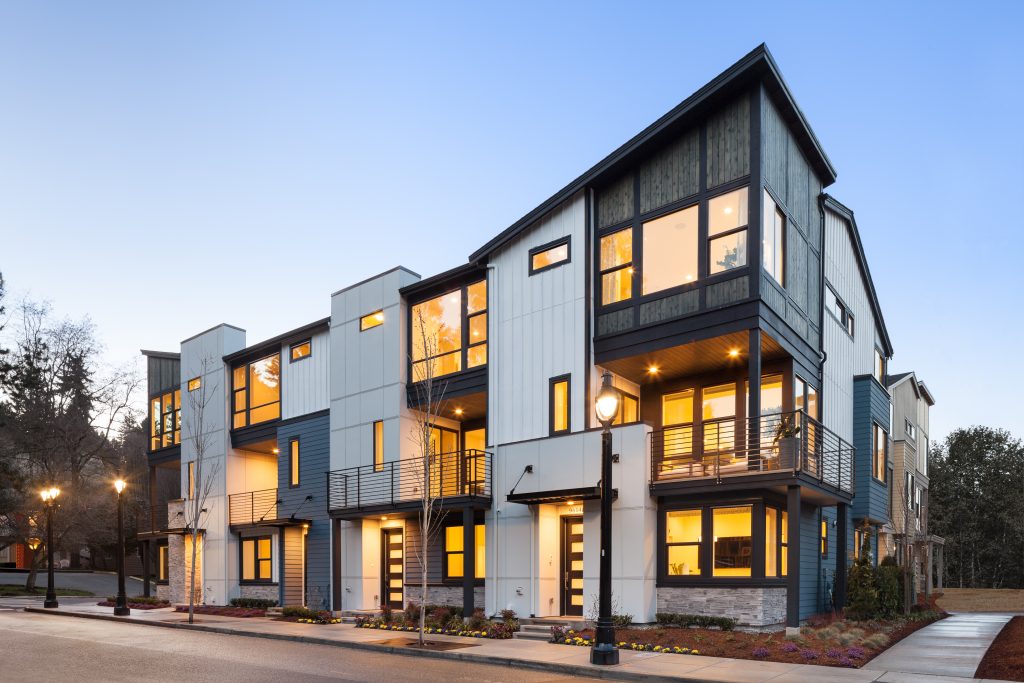Kirkland community features award-winning floor plans

Distinguished by a sought-after Kirkland address, Crosswater is a boutique community of 16 luxury townhomes characterized by contemporary architecture and a private setting.
The community, built by Toll Brothers, just opened for presales, offering interested homebuyers the chance to get in early and personalize their homes to their style and taste.
The homes range in size from 1,941 to 2,194 square feet. All of the plans have 3.5 baths.
“One popular design that we’re featuring here is our Burke plan,” says Sheri Putzke, community sales manager. “Its incredible great room surrounded by impressive floor-to-ceiling windows has made this an award-winning design. All of our floor plans are thoughtfully designed with efficient layouts appreciated by homeowners. Flex spaces on the lower level offer versatility as an office, bonus room or guest suite.”

The Burke is one of the floor plans available at Crosswater. The community’s three- and four-bedroom townhomes range from 1,941 to 2,194 square feet.
All Toll Brothers homebuyers are offered two complimentary consultations with a designer at the Kirkland Design Studio. At these sessions, buyers can select hardware, paint colors, lighting, cabinets and countertop surfaces, as well as many other design touches to distinguish their home.
As part of the builder’s national sales event, homebuyers who purchase by Sept. 29 receive 50% off Design Studio options up to $30,000, plus additional vendor incentives.
“These appointments are a big hit with our buyers and a huge perk of working with Toll Brothers,” says Putzke. “Buyers have an opportunity to touch and feel the finishes, and select options for their home based on their personal taste. Even if they choose to stay within the included features, they still have choices. It’s not like they’re limited to just A, B or C color schemes. At the same time, if they do choose to upgrade, they have even more options. Agents are welcome to accompany their customers to help select items that might offer a better return on investment in the long run.”
Residents living at Crosswater will appreciate the central Kirkland location, with nearby casual and fine dining and convenient shopping. Juanita Beach Park is nearby, providing easy access to water activities on Lake Washington, and Juanita Village is 2 miles away.
The community is located close to I-405 and major employment centers in Bellevue, Redmond and Seattle. Children living at Crosswater can attend schools in the highly rated Lake Washington School District.
“The quiet location really distinguishes the community as it’s set back from the road,” says Putzke. “There’s a lot of vegetation and it’s situated in a peaceful, lush setting.”
CrosswaterPrices: From the low $800,000s |
This article originally appeared in on SeattleTimes.com
To Buy New or Old, That is the Question


We are often asked, “Which is the better buy, a newer or older home?” Our answer: It all depends on your needs and personal preferences. We decided to put together a list of the six biggest differences between newer and older homes:
The neighborhood
Surprisingly, one of the biggest factors in choosing a new home isn’t the property itself, but rather the surrounding neighborhood. While new homes occasionally spring up in established communities, most are built in new developments. The settings are quite different, each with their own unique benefits.
Older neighborhoods often feature tree-lined streets; larger property lots; a wide array of architectural styles; easy walking access to mass transportation, restaurants and local shops; and more established relationships among neighbors.
New developments are better known for wider streets and quiet cul-de-sacs; controlled development; fewer aboveground utilities; more parks; and often newer public facilities (schools, libraries, pools, etc.). There are typically more children in newer communities, as well.
Consider your daily work commute, too. While not always true, older neighborhoods tend to be closer to major employment centers, mass transportation and multiple car routes (neighborhood arterials, highways and freeways).
Design and layout
If you like Victorian, Craftsman or Cape Cod style homes, it used to be that you would have to buy an older home from the appropriate era. But with new-home builders now offering modern takes on those classic designs, that’s no longer the case. There are even modern log homes available.
Have you given much thought to your floor plans? If you have your heart set on a family room, an entertainment kitchen, a home office and walk-in closets, you’ll likely want to buy a newer home—or plan to do some heavy remodeling of an older home. Unless they’ve already been remodeled, most older homes feature more basic layouts.
If you have a specific home-décor style in mind, you’ll want to take that into consideration, as well. Professional designers say it’s best if the style and era of your furnishings match the style and era of your house. But if you are willing to adapt, then the options are wide open.
Materials and craftsmanship
Homes built before material and labor costs spiked in the late 1950s have a reputation for higher-grade lumber and old-world craftsmanship (hardwood floors, old-growth timber supports, ornate siding, artistic molding, etc.).
However, newer homes have the benefit of modern materials and more advanced building codes (copper or polyurethane plumbing, better insulation, double-pane windows, modern electrical wiring, earthquake/ windstorm supports, etc.).
Current condition
The condition of a home for sale is always a top consideration for any buyer. However, age is a factor here, as well. For example, if the exterior of a newer home needs repainting, it’s a relatively easy task to determine the cost. But if it’s a home built before the 1970s, you have to also consider the fact that the underlying paint is most likely lead0based, and that the wood siding may have rot or other structural issues that need to be addressed before it can be recoated.
On the flip side, the mechanicals in older homes (lights, heating systems, sump pump, etc.) tend to be better built and last longer.
Outdoor space
One of the great things about older homes is that they usually come with mature tress and bushes already in place. Buyers of new homes may have to wait years for ornamental trees, fruit trees, roses, ferns, cacti and other long-term vegetation to fill in a yard, create shade, provide privacy, and develop into an inviting outdoor space. However, maybe you’re one of the many homeowners who prefer the wide-open, low-maintenance benefits of a lightly planted yard.
Car considerations
Like it or not, most of us are extremely dependent on our cars for daily transportation. And here again, you’ll find a big difference between newer and older homes. Newer homes almost always feature ample off-street parking: usually a two-care garage and a wide driveway. An older home, depending on just how old it is, may not offer a garage—and if it does, there’s often only enough space for one car. For people who don’t feel comfortable leaving their car on the street, this alone can be a determining factor.
Finalizing your decision
While the differences between older and newer homes are striking, there’s certainly no right or wrong answer. It is a matter of personal taste, and what is available in your desired area. To quickly determine which direction your taste trends, use the information above to make a list of your most desired features, then categorize those according to the type of house in which they’re most likely to be found. The results can often be telling.
If you have questions about newer versus older homes, contact your local Windermere Real Estate broker to learn more!
This post originally appeared on the Windermere.com Blog.

 Facebook
Facebook
 X
X
 Pinterest
Pinterest
 Copy Link
Copy Link




